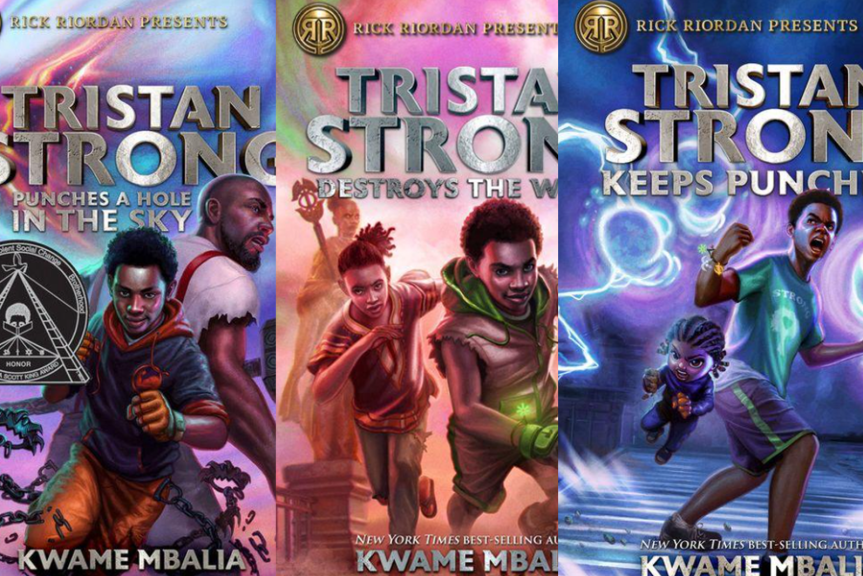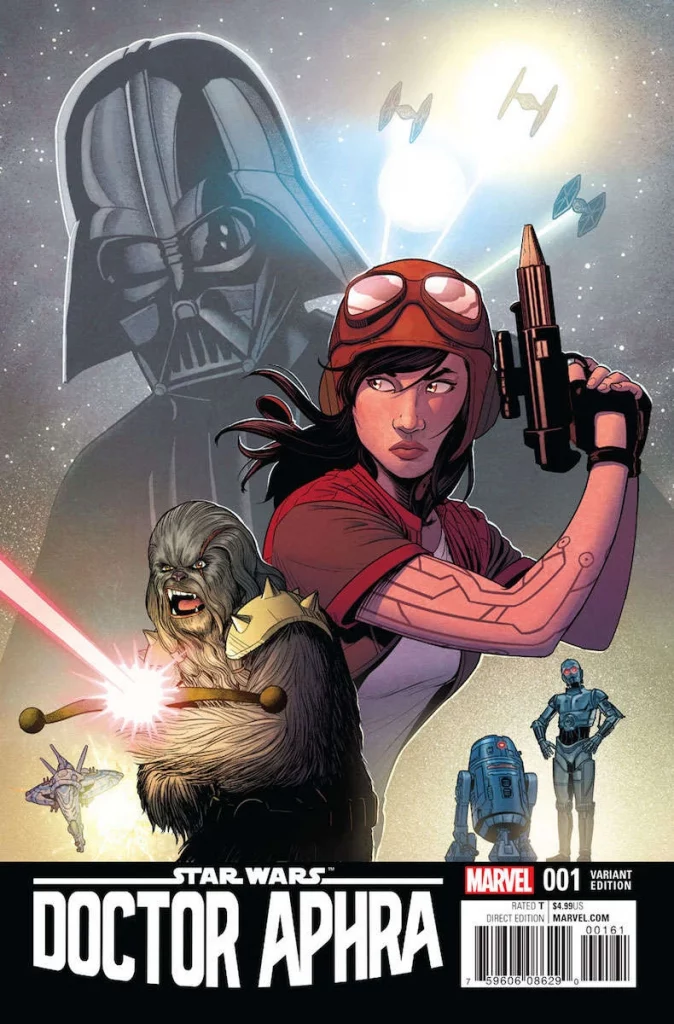Martha Wells has become a household name, especially among the science fiction and fantasy community. Her books have explored fantastical worlds and the far-flung futures of our own world. She’s won multiple awards for her work, particularly the Murderbot Diaries. Books in the Murderbot Diaries have won Hugo, Locus, and Nebula awards!
Jean Marie Ward sat down with Martha Wells to talk about her writing process, fandom, and much more!
If you’d like to read this interview in print, check Issue 56 of Galaxy’s Edge Magazine.
…
Galaxy’s Edge: You said that you were always a reader. When did you realize you wanted to become a writer?
Martha Wells: Really early on. I remember telling my parents when I was in high school that I wanted to be a writer and them not having much reaction to it. At the time, I think I wanted to major in journalism when I went to the university, because that was the only way I could conceive of being a writer at that point. I didn’t know how you went about being a fiction writer. That’s not something I figured out until I went to Texas A&M and took a writing workshop with Steven Gould and started going to conventions and learning about how you actually do become a fiction writer.
Galaxy’s Edge: You just mentioned conventions, which is a great lead into my next question: What role did fandom and fan fiction play in your journey to publication?
Martha Wells: A huge, huge role, because the reason I picked Texas A&M University was they had a student science fiction and fantasy group. I’m not sure I knew at that point that they also ran conventions. I’d actually been to ArmadilloCon in Austin when I was in high school. I somehow convinced my parents to take me and a friend down there to go to this convention—ArmadilloCon—on Saturday. This was back when it was teeny tiny—the dealer’s room was basically the size of a hotel room. And that really made me want to continue to see conventions.
Also, the friendship and the people I met working on the student convention, AggieCon, were hugely important to me. I’d been reading fanfic for a while. I think I discovered it probably around 1983, I think … no, it was 1980 when Empire Strikes Back came out. So, I’d been reading fanfic for a while already and trying to write … I was first starting to write when I was in high school and college. I worked on fanfic and met a lot of people in fandom through that too. It was hugely important for me.
Galaxy’s Edge: And you ran AggieCon at least one year.
Martha Wells: Yeah, I worked on it for the whole four years I was in college and the last year I [chaired it]. I believe it was 1986. It’s been so long.
Galaxy’s Edge: That’s what it said in Wikipedia.
Martha Wells: Yeah, I was running the convention. And it was great. It was a huge learning experience. It was exhausting and incredibly stressful and anxiety-inducing. But later on, you’re like, “Yeah, that was really great.”
Galaxy’s Edge: I would imagine it gave you an interesting perspective on conventions and the business of conventions from a writer’s standpoint.
Martha Wells: I think it did. It also let me meet a lot of writers and hear a lot about publishing and a lot of discussions about the technical and creative aspects of writing and how everything worked. That was really important.
Galaxy’s Edge: What influence did your college major, anthropology, have on your first novel, The Element of Fire, and subsequent works?
Martha Wells: I think it’s had an influence on a lot of my work because of the worldbuilding. Being able to look at how cultures develop over time and the things that go wrong, and looking at the material culture of a city or a civilization and trying to take a holistic approach to worldbuilding and all the things that you have to know—even if you don’t put them on the page—about how your city works, your culture works, all those things, that was hugely helpful to me.
Galaxy’s Edge: I imagine, especially when you’re dealing with non-human characters such as those in The Books of the Raksura, that knowing how the pieces fit, sociologically speaking, would be a great help.
Martha Wells: Yeah, and the kind of things the people would have when you’re dealing with an alien character. What kind of culture would create that character? What does that mean? What’s important to them? What kind of material goods would they have? What does where they live look like? What kind of environment would this be happening in? All that kind of stuff.
Galaxy’s Edge: You have incredible worldbuilding in all your series, whether it be Ile-Rien’s early industrial culture, the worlds of the Raksura, and of course, the Murderbot Diaries. Is anthropology the secret to that, or is there something else?
Martha Wells: I think it’s your character point of view, and really thinking, trying basically to run their software on your hardware, and trying to really see things through their eyes and what is important to them, what do they want to do, how has their world shaped them. I think that’s the key.
Galaxy’s Edge: You’ve mentioned in various interviews that you’re not athletic, yet you create these very complex and brutal fight scenes. In The Murderbot Diaries you literally have multiple points of view in a single character’s head, because Murderbot is pulling in all of these feeds from drones, from artificial intelligences, anything that it can, in real time. So, the reader sees the action from a lot of viewpoints, and they’re all very, very intense. How do you as somebody who has, essentially, one point of view, deal with that? How do you deal with being a relatively peaceable woman who doesn’t go out and commit mayhem, whether in a dojo or in real life? How do you create these battle scenes?
Martha Wells: Well, I watch a lot of TV and movies, and I pay a lot of attention to fight scenes. Actually, when I was younger, I did take tae kwon do, and I did fencing for a little bit. It’s not something I can do anymore, though I try to exercise. When we’re not in a pandemic, I can actually go to the gym and things like that. But again, it’s the character point of view, getting the physicality of the character in your head and what they can and can’t do. Also, the parameters of the fight as you have set them for yourself, like a sword fight or a knife fight. A fistfight is so very different from a fight where the characters are actually armed with some kind of weapon, especially a single-shot weapon or an automatic weapon. Or like Murderbot when it can bring in all these different views of the scene and can use all these different ways to attack whoever is attacking it.
So yeah, just keeping all that straight and, again, really getting into the [character’s] point of view and thinking about that. That’s one of the reasons Murderbot often takes a long time to write. Having to do those multiple viewpoints is really complicated and often takes a long time to put together. Just the logistics of the stories are very different from any other kind of logistics for the other things I’ve written. Even though I mostly write adventure fiction, Murderbot is just so much more complicated in what happens, even though it might not feel that way to the reader. And yeah, watching a lot of TV and movies and watching people … watching fight scenes for years and years, and looking at what people do, and what it’s possible to do. That’s another fun thing about Murderbot: you can have the character do a lot of things that’s not possible for a human to do or even an alien character to do. That’s basically it.
Galaxy’s Edge: And Murderbot can take a lot of damage that an entirely organic being cannot do and remain itself. Speaking of Murderbot and its abilities, you worked in software development for a while. What role did your professional experience in software development play in the creation of The Murderbot Diaries and the development of Murderbot’s personality, abilities, and outlook?
Martha Wells: It played a big role because that was my primary experience with IT when I worked there. A lot of people think that I must know a lot about artificial intelligence. I don’t know anything about real AI. What I know about is the fake AI I invent for my books. But the way Murderbot often solves problems, answers questions, and solves mysteries is usually by manipulating data, which is one of the things I did when I worked for … well, I don’t want to name them. But when I worked in IT. I built databases and wrote programs—in COBOL, that’s how long ago it was—for databases for user interfaces, basically. So Murderbot uses that a lot to solve problems, and that’s the viewpoint I try to look at it from. I think that’s one reason why people think the character feels realistic as a machine intelligence, because it does look at things in terms of: What is the data we have? How can it be manipulated to give us answers?
Galaxy’s Edge: Murderbot and a lot of your characters are outliers and odd persons out. What draws you to characters who are isolated or find themselves in this position?
Martha Wells: I was a really isolated little kid. I probably have some still undiagnosed issues that back then people just didn’t understand or have any concept of. It made me live in my head a lot. I have a sister who’s nine years older than me, so there was usually nobody around my age. Where we lived there were no other kids on our street. There were some nearby, but the way the traffic was and where we lived and everything, it’s not like I could go out and play with kids every day like a lot of people were able to in other neighborhoods. So just feeling very different, always feeling very different and isolated, is just something that I’m still dealing with all my life. I guess you just get it kind of imprinted on your consciousness early, and it’s not something that never leaves you.
Galaxy’s Edge: It’s something we can all relate to. At some point, I don’t care how extroverted you are, you will be alone and say to yourself, “What do I do now? Where am I? Who am I? And how do I fit in? How can this square object fit into these round holes that everybody else is fitting in?”
Martha Wells: Pretty much so.
Galaxy’s Edge: While we’re still, more or less, on the subject of Murderbot, is there anything that you want people to take away from the series? What do you want them to know about it?
Martha Wells: One of the things I noticed people get wrong a lot—and I think that’s because it gets reprinted in reviews and things—is that Murderbot did not have consciousness before it hacked its governor module somehow. And it’s like no, all the SecUnits are conscious. I was trying to make that clear in Network Effect. They’re all conscious, all the time. It’s just that they’re enslaved. They’re mentally enslaved, and there’s not much they can do that we know without activating the governor module and getting killed, basically. And it is slavery. I’ve also seen reviews try to argue that somehow the humans are nice to them, and it’s not slavery. It’s like no, it absolutely is. It’s intentional. That’s what it is.
Galaxy’s Edge: It’s rather like that line from The Twelve Chairs, “My master, Ippolit Matveyevich Vorobyaninov. He was a Marshal of the nobility. I loved him. He hardly ever beat us.”
Martha Wells: Yeah. Also in Thor: Ragnarok, the prisoners with jobs.
Galaxy’s Edge: That notion seems to be really hard for some people to understand for some reason. Personally, I cannot imagine how you can lack consciousness and still hack your governor module. To me, the question was a non-issue. Since the SecUnits were, for want of a better term, conscious entities, it was obvious this was some kind enslavement.
Martha Wells: It’s a mental gymnastics that people do and it’s just … I don’t know why people don’t want to admit that human beings enslave other human beings and would continue to do that if allowed to. I don’t know why they’re willfully blind on that point. Looking at history, or current affairs, or anything would seem to, you know, get [that point] through to them. But no.
Galaxy’s Edge: You just won the Hugo Award for Best Novel and Best Series. This is just one little cluster in the many, many awards you’ve been nominated for or won throughout your career in science fiction and fantasy. How important are awards for the career of a writer in science fiction, fantasy, or any genre?
Martha Wells: Actually, before Murderbot, I’d only been nominated for a Nebula Award. That was for The Death of the Necromancer, and you know, I didn’t win.
Galaxy’s Edge: You were nominated for the Compton Crook and Crawford Awards for The Element of Fire.
Martha Wells: Yeah, I guess I should say I’ve only been nominated for one major award. I did get nominations of some other minor ones, but only a few really. Before Murderbot, I was pretty much off the radar as far as awards were concerned, which is fine. I never thought I would even have a chance at being on the Hugo ballot, let alone revel in the Hugo long list, let alone, you know, win them. I think it’s kind of hard to say how much impact they have. They do have, I think, a big impact within the genres in how people see you.
I think the impact of the Hugo Awards has changed a lot in the past ten years or so, since more people started to get supporting memberships so they could nominate, and we started having a more diverse ballot that better reflected what people were actually reading and what people were considering was the cutting edge of science fiction and fantasy. So, I think it’s had more impact since then.
I think there is what’s known—especially for the novels—as a bump in sales from just being on something like the Hugo ballot or the Nebula ballot. For me, the biggest impact was validation of 25 years or however many years of work to get to this point. It was a validation of the fact that I didn’t give up when it would have been really easy and probably smart to, at certain points, just go get a different job. So, it was hugely important to me personally, and I think it’s made a big change in how I’m treated just in fandom and the genre.
There are some exceptions, but usually women my age who are still trying to be working writers are not treated very well, either at conventions or in general in the genre, because we’re fading out and so need to not clutter up the landscape by still existing and still writing. It’ll be interesting to see what happens after this. I haven’t seen much …. Because of the pandemic, of course, everything’s just slowed down. So, we’re not gathering at conventions and events and things like that.
But, yeah, most of the impact has been personal, I would think. You kind of can’t measure other ways. The publisher can probably answer a lot more accurately about [the effect on] sales and things like that.
Galaxy’s Edge: Increased sales are good, and validation and recognition are also good. Speaking of good things, in 2021 you signed a six-book contract with Tor, which will include at least three more entries in The Murderbot Diaries. The first announced title in the contract is a second-world fantasy called Witch King. Can you tell us anything about Witch King, and what’s next for Murderbot?
Martha Wells: It is a completely new secondary world fantasy, kind of epic in scope. It’s my take on epic worldbuilding, and I was trying to do something different with it. Hopefully, people will like it. It’s going to come out in 2023. It was originally intended for this year, but it’s gotten pushed back because of everything that was going on. The book was actually finished late last year, but I’m working on the revision right now. Hopefully, everybody will enjoy it.
Galaxy’s Edge: I’m looking forward to it. Human characters or non-human characters?
Martha Wells: A mix of both. Again, it’s a different world from anything I’ve done before, with a mix of kind of humans and magical humans, like demons and other different types. It should be a lot of fun.
Galaxy’s Edge: Cool! Finally, the soapbox question, is there anything you’d like to add? Anything you want to talk about?
Martha Wells: Probably Murderbot, because I am doing another Murderbot novel. I’m writing one right now. I see a lot of people asking about it. It’s about halfway finished. It’s due in the summer, so I should have it done by then. After this novel, there’ll be at least one more novella and a novel, but I’m not sure what order they’re in. They’re going to take place after Network Effect. And in fact, this novella starts up right not very long after the end of Network Effect.
Galaxy’s Edge: Great! We’re all going to be looking forward to that. Thank you very, very much.



























